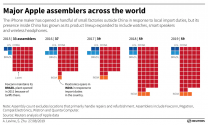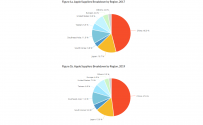Thats the thing though. When production is moved out, foreign component makers will also eventually rise and replace China's.
You're not wrong about component makers, but your premise about assemblers moving out is wrong, as I've yet to seen any measurable shift in production in the numbers. At least for Apple/Foxconn, they have been clamoring to reduce production in China since 2007; almost all attempts have failed. Numbers don't lie:


You might be fooled into thinking they are leaving China if all you read in news reports is the new plants being constructed outside China, neglecting the simultaneous production expansion within China that dwarfs anything in India or Vietnam. And the first graph refers to just
assembly; the one you have been complaining about.
puts this well:
But the factories outside China are smaller and, in the case of India and Brazil, Apple only uses them to meet domestic demand. Apple's contract factories inside China, meanwhile, have added far more locations than outside, with Foxconn alone expanding from 19 locations in 2015 to 29 in 2019 and Pegatron going from eight to 12, according to Apple's data. The new locations come as Apple has added watches, smart speakers and wireless headphones to its product lineup.
And beyond the contract factories, the rest of Apple's suppliers-the companies that sell it chips, glass, aluminum casings, cables, circuit boards and much more-became more concentrated in China. Among all supplier locations, 44.9% were in China in 2015 , a proportion that rose to 47.6% by 2019, the data showed.
Even if Apple can make devices in India or Vietnam, the volumes would be small compared with Apple’s overall needs.
Outside of China, “there few places in the world that have the infrastructure to produce 600,000 phones a day,” said Dave Evans, chief executive of San Francisco supply chain firm Fictiv.
From another source, MarcoPolo's
:
[Between 2017 and 2019, China's share of Apple suppliers rose from 349 to 383, corresponding to a share increase from 46% to 47.9% of all Apple suppliers. Southeast Asia and Japan's share have decreased between 2017 and 2019, in contrast.]
Not only did Apple concentrate more suppliers in China from 2017-2019, it also increased its overall supplier presence in East Asia, from 83.6% to 86.5%. Taiwan and South Korea also gained slightly, possibly at the expense of Japan because they manufacture substitutable products, though that's difficult to determine precisely from the data. To the extent there is some diversification from China, the shifts have been largely intra-Asia among Asian suppliers. Some Japanese, and even Chinese, firms have relocated to Southeast Asia.
Among the “Others” category, Apple seemed to have
shifted away from Mexico (from 7 to 4 entities), while India gained more supplier entities in those two years. Perhaps it is no coincidence that Indian newspapers have been
that Apple may shift one-fifth of its manufacturing from China to India, though
that is
far more aspirational than anything approaching reality.
To borrow Robert Solow's
:
you can see supply chain decoupling “everywhere except in the numbers. ”
Considering how Apple began trying to diversify as early as 2007 from China, you would have expected them to make some measurable progress. Or even during the trade war of the past 2 years, yet they've been doing the opposite of "diversifying from China". Because even as they may announce flashy new factories in Brazil, or Vietnam, or India, they're simultaneously opening much more new factories in China at the same time.
That's not to mention the supply chain troubles in other countries which have previously led to Apple backing off from diversification. For example, Brazil saw its plants closed despite Apple/Foxconn pledging to invest $12 billion and 100000 jobs into the country in 2011. Apple/Foxconn also tried, and failed, to set up production bases in
. Vietnam investment might actually work this time as its infrastructure improves, but as it sits right next to China, it can benefit from depending on their comprehensive supply chain, and neither is the country nearly large enough to meaningfully replace Chinese capacity.
In 2015, Foxconn, Apple's main supplier,
that India would have 12 plants and 1 million Indian workers by this year, as well as a
to create 50,000 jobs in Maharashtra back in 2015. Both of these did not live up to their hype. From the MarcoPolo article, Apple added 34 new supplier bases in China between just 2017 and 2019, and reduced 3 from "other countries" (which includes India). While in India, Foxconn is nowhere even close to having 1 million workers in India,
their $5 billion plant they had promised the Maharastra gov't back in 2015 in early 2020. They came back with a far more paltry $1-billion investment to expand an existing plant and create just 6000 jobs, which was hyped up by Indian media a few months ago with great fanfare (for context, Foxconn still employs somewhere around 1.3 million workers in China, despite spending more than a decade of trying, and failing, to diversify away from it). Meanwhile, Foxconn continues to build its most advanced factories in China,
10 "lighthouse factories" (fully automated factories, eliminating the need for low-wage workers) in the country in 2020, and constructing another 10 this year.
Also, when you move production out of China, don't be surprised when you're outcompeted on cost and scale, and pushed out of business:
. Interestingly, Panasonic based its production out of Malaysia, but nevertheless they couldn't compete. If Foxconn tries to leave, fine; more industrial capacity for Luxshare to outcompete and kill Foxconn on.


